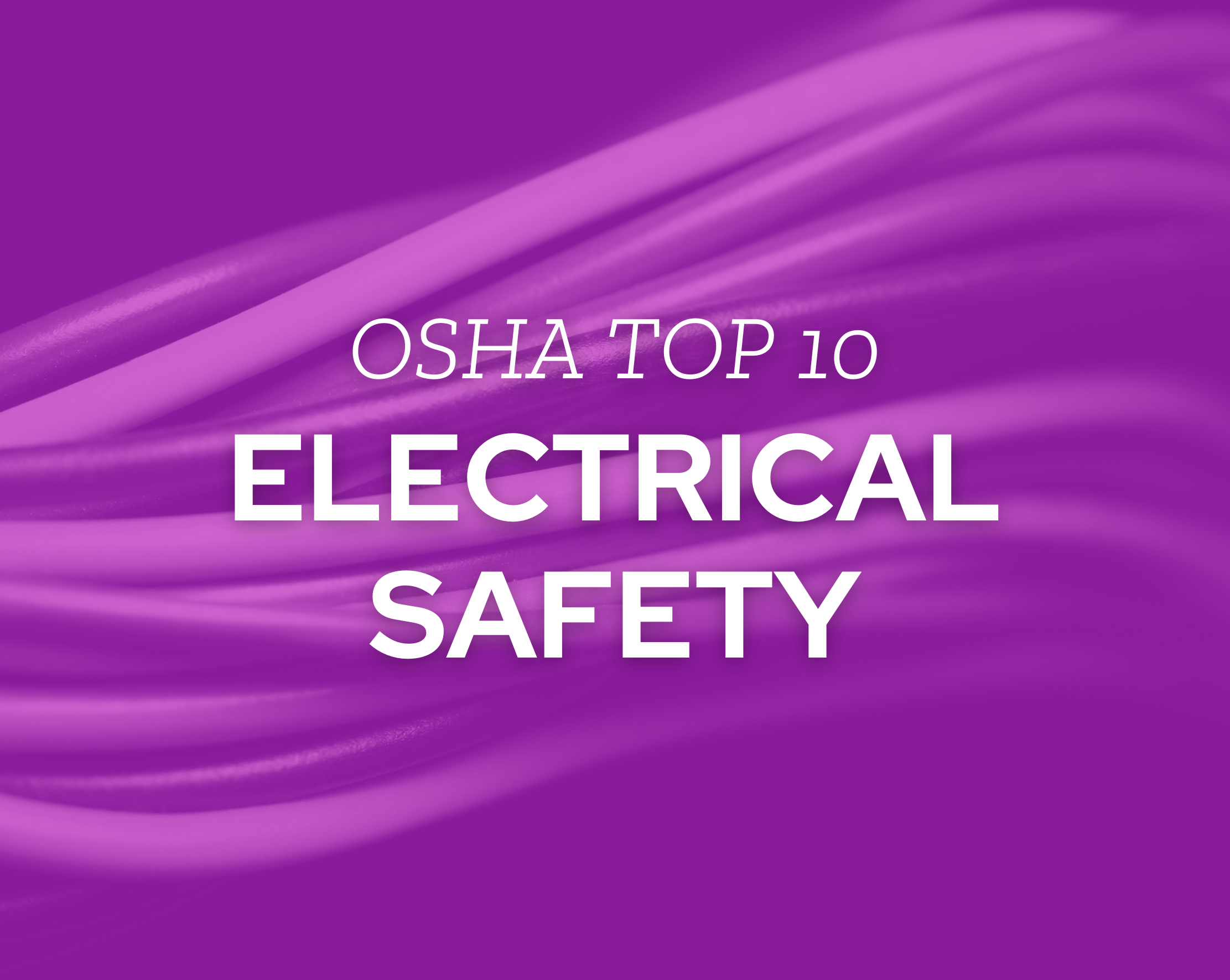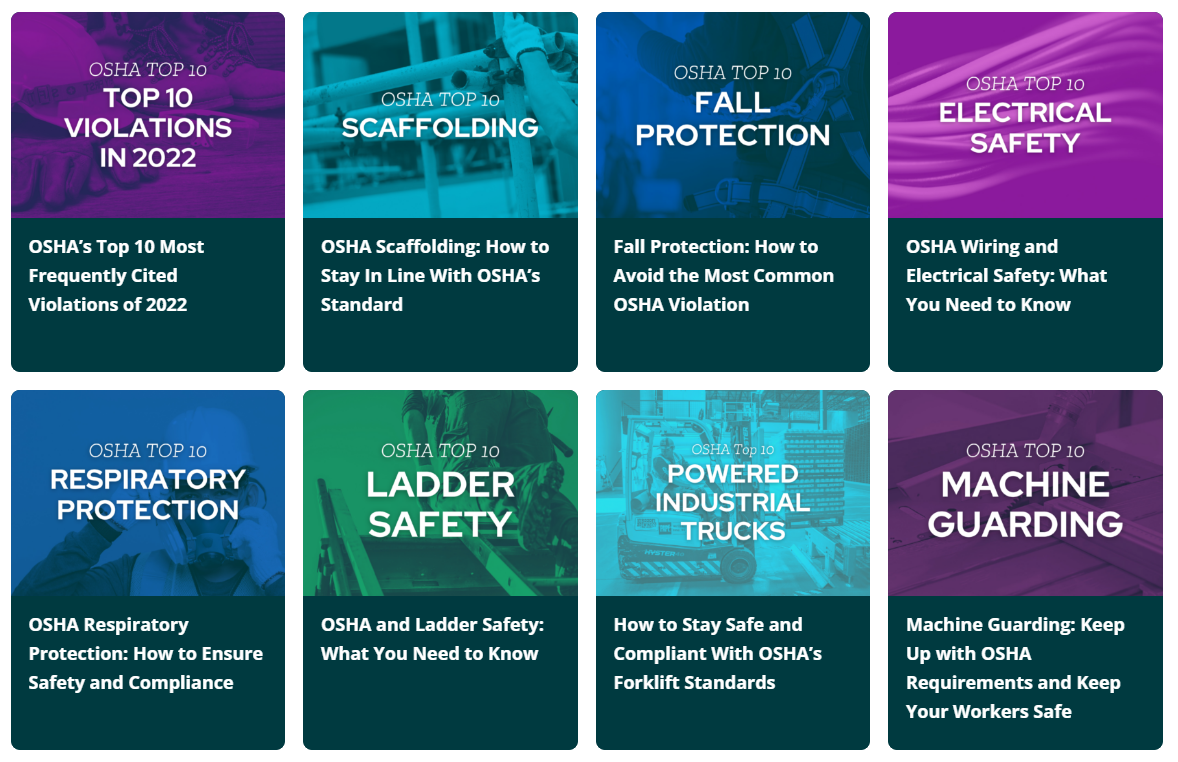OSHA Wiring and Electrical Safety: What You Need to Know
Do you know everything you need to know about the 10 most frequently cited Occupational Safety and Health Administration standards? In this series, we’re exploring the most common OSHA violations, one by one. Keep reading to learn how to avoid an electrical violation and protect your workforce from electrical risks.
OSHA Electrical Standard: What It Is
OSHA definition:
“Many workers are unaware of the potential electrical hazards present in their work environment, which makes them more vulnerable to the danger of electrocution. The following hazards are the most frequent causes of electrical injuries: contact with power lines, lack of ground-fault protection, path to ground missing or discontinuous, equipment not used in manner prescribed, and improper use of extension and flexible cords.” (Source)
Simple definition:
Electricity is dangerous. Employees risk electrocution any time they’re working with or around machines that conduct or generate electricity.
Wiring is one of the most common sources of electrical hazards. Why? Because wires are potent sources of electricity that are a) practically everywhere and b) relatively fragile. Wires—particularly flexible wires—cover wide areas, may be misconfigured, and can wear down easily, making hazards difficult to manage.
Examples of electrical hazards include the following:
- torn, frayed, or exposed wires
- tangled and/or overcrowded wires
- loose electrical connections
- substandard insulation
- malfunctioning electrical equipment
- ungrounded equipment
- broken ground connections
- improper use of extension cords and/or power strips
Why OSHA Electrical and Wiring Violations Happen
Many violations of OSHA’s electrical standard can be characterized simply as the wrong wire in the wrong outlet. Flexible cords (the ones usually connected to household appliances) are frequently unsafe in industrial settings. The cords may not be adequately secured against strain and may loosen or tear as a result, creating hazards along the length of the wire and/or at the site of connection with the outlet.
Often, electrical hazards occur due to wire misplacement. Perhaps a cord is too close to metal, a water source, or another conductive substance. Or maybe the cord is wrapped around a sharp edge, which could lead to tearing or breakage.
Organizations need to be careful about using temporary wiring in lieu of fixed wiring. Temporary wiring, as you might imagine, should not be used to power permanent fixtures. It should not run through holes in walls, ceilings, or floors; be attached to building surfaces; or be concealed behind walls, ceilings, or floors.
Other times, organizations get written up for violations because electrical equipment isn’t sufficiently guarded. Live parts must not be exposed or within reach. If an employee can touch a powered-on lightbulb, for instance, OSHA may count it as a hazard.
Sometimes, electrical hazards result from ungrounded or uninsulated equipment. All power supply systems need to be grounded and all tools need to be double-insulated.
Many electrical violations are related to lockout/tagout issues. Perhaps the organization lacks documented lockout/tagout procedures, doesn’t perform audits or inspections regularly, or can’t prove that employees are following all required steps in the correct order.
Finally, as with every other OSHA violation, inadequate training is a significant risk factor. Employees need to be thoroughly trained in electrical safety and informed about potential hazards.
Read up on all of the top violations in the
OSHA Top 10 Resource Hub
What You Stand to Lose When Electrical Violations Happen
Direct costs: OSHA penalties can exceed $15,000 per violation—and as much per day for every day the issue hasn’t been fixed by OSHA’s deadline. The fine for a willful or repeated violation can be 10 times as much.
Indirect costs:
- workers’ compensation claims from workers who suffer electrical shock
- lost productivity due to illnesses and injuries caused by electrocution
- equipment breakages due to poor electrical practices
- legal and compliance fees
- decreased morale
- negative publicity and reputational damage
Signs You’re at Risk of an Electrical Violation
More machines and more wires mean more potential hazards.
OSHA requires fixed wiring in many contexts. The flexible cords we’re all familiar with don’t always suffice.
Workers should not be doing their jobs inches away from cords and or lighting fixtures.
Wires, outlets, and electrical systems wear down over time. If you’re relying on old, outdated, or poorly maintained equipment, your workforce is likely in danger.
Unless you’re an electrician, your wiring shouldn’t be a DIY project.
Anyone who could be exposed to an electrical hazard should be trained and up-to-date with electrical safety.
How to Avoid an Electrical Wiring Violation: Your Prevention Checklist
1. Are only qualified people allowed to work on electrical equipment, and are they familiar with state and federal OSHA electrical safety rules?
2. Is a lockout/tagout program available where repairs are made to facility equipment by in-house personnel?
3. Are all portable handheld electrical tools and equipment grounded or double-insulated?
4. Are electrical appliances—such as refrigerators, coffee pots, vacuum cleaners, polishers, and vending machines—grounded?
5. Do all extension cords have ground prongs?
6. Do you repair or replace damaged wiring or frayed cords promptly?
7. If you work in damp or wet areas, are your electrical tools and equipment approved for the kind of work you do?
8. Are metal ladders prohibited from use in areas where there could be exposure to energized parts of equipment, fixtures, or circuit conductors?
9. Are all disconnecting switches labeled to indicate their use or the equipment they serve?
10. Are electrical cords free from splicing?
11. Is every electrical room clearly marked?
12. Do switches, receptacles, and junction boxes have tight-fitting covers or face plates?
13. Are flip covers provided for electrical outlets in wet areas?
14. Are there GFCI (ground-fault circuit interrupter) outlets in areas that are 6 feet or less from water sources?
15. Are electrical panels cleared 36 inches in front of each panel?
You Don’t Have to Manage Your OSHA Requirements Alone
Have questions? Looking for more detailed OSHA compliance guidance?
KPA is here to help.
To truly protect your workforce and bottom line, you’ll need in-depth information—and not just about OSHA’s top 10, but every potential hazard that exists in your organization. You’ll also need to conduct a thorough evaluation of your facilities to identify current gaps and risk areas.
KPA’s unique combination of software, training, and consulting services can provide the coverage your people and your organization need. For more information and guidance about preventing an electrical violation, please contact us.


